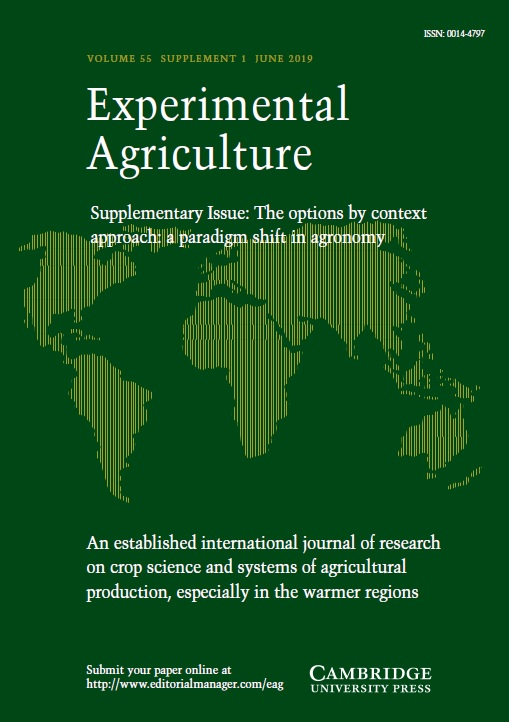Crossref Citations
This article has been cited by the following publications. This list is generated based on data provided by
Crossref.
Dahniya, M. T.
Hahn, S. K.
and
Oputa, C. O.
1985.
Effect of Shoot Removal on Shoot and Root Yields of Sweet Potato.
Experimental Agriculture,
Vol. 21,
Issue. 2,
p.
183.
PACE, R. D.
DULL, G. G.
and
PHILLS, B. R.
1985.
Proximate Composition of Sweet Potato Greens in Relation to Cultivar, Harvest Date, Crop Year and Processing.
Journal of Food Science,
Vol. 50,
Issue. 2,
p.
537.
Pace, R.D.
Dull, G.G.
Phills, B.R.
Bonsi, C.
and
Forrester, I.T.
1988.
The effect of topping frequency on nutrient content of sweet potato green tips.
Journal of Food Composition and Analysis,
Vol. 1,
Issue. 4,
p.
326.
Mozafar, A.
1993.
Nitrogen fertilizers and the amount of vitamins in plants: A review.
Journal of Plant Nutrition,
Vol. 16,
Issue. 12,
p.
2479.
Almazan, Aurea M.
Begum, Fatima
and
Johnson, Colette
1997.
Nutritional Quality of Sweetpotato Greens from Greenhouse Plants.
Journal of Food Composition and Analysis,
Vol. 10,
Issue. 3,
p.
246.
Ravi, V.
and
Indira, P.
1998.
Horticultural Reviews.
p.
277.
YOSHIMOTO, Makoto
YAHARA, Shoji
OKUNO, Shigenori
ISLAM, Md. Shahidul
ISHIGURO, Koji
and
YAMAKAWA, Osamu
2002.
Antimutagenicity of Mono-, Di-, and Tricaffeoylquinic Acid Derivatives Isolated from Sweetpotato (Ipomoea batatasL.) Leaf.
Bioscience, Biotechnology, and Biochemistry,
Vol. 66,
Issue. 11,
p.
2336.
Mulungu, Loth S.
., Daniel J. Mwailana
., Shazia S.O.W. Reuben
., J.P. Akwilin Tarimo
., Apia W. Massawe
and
., Rhodes H. Makundi
2006.
Evaluation on the Effect of Topping Frequency on Yield of Two Contrasting Sweet Potato (Ipomoea batatas L.) Genotypes.
Journal of Applied Sciences,
Vol. 6,
Issue. 5,
p.
1132.
Larbi, A.
Etela, I.
Nwokocha, H.N.
Oji, U.I.
Anyanwu, N.J.
Gbaraneh, L.D.
Anioke, S.C.
Balogun, R.O.
and
Muhammad, I.R.
2007.
Fodder and tuber yields, and fodder quality of sweet potato cultivars at different maturity stages in the West African humid forest and savanna zones.
Animal Feed Science and Technology,
Vol. 135,
Issue. 1-2,
p.
126.
Snelder, D. J.
2008.
Smallholder Tree Growing for Rural Development and Environmental Services.
Vol. 5,
Issue. ,
p.
37.
Padmaja, G.
2009.
The Sweetpotato.
p.
189.
Lim, T. K.
2016.
Edible Medicinal and Non-Medicinal Plants.
p.
92.
Alam, Mohammad
Rana, Ziaul
and
Islam, Sheikh
2016.
Comparison of the Proximate Composition, Total Carotenoids and Total Polyphenol Content of Nine Orange-Fleshed Sweet Potato Varieties Grown in Bangladesh.
Foods,
Vol. 5,
Issue. 3,
p.
64.
Jackson, D. Michael
Harrison, H. F.
Jarret, R. L.
and
Wadl, P. A.
2019.
Phenotypic analysis of leaf colours from the USDA, ARS sweetpotato (Ipomoea batatas) germplasm collection.
Plant Genetic Resources: Characterization and Utilization,
Vol. 17,
Issue. 04,
p.
325.
Yusupova, G.G
Yusupov, R.Kh
and
Smyatskaya, J.
2020.
The effect of sweet potato powder on the physical, chemical and organoleptic indicators of bread quality.
E3S Web of Conferences,
Vol. 161,
Issue. ,
p.
01054.
Sajeev, M. S.
Padmaja, G.
Jyothi, A. N.
Krishnakumar, T.
and
Pradeepika, C.
2023.
Vegetables for Nutrition and Entrepreneurship.
p.
409.
Gao, Xiao-ru
Zhang, Huan
Li, Xu
Bai, Yi-wei
Peng, Kui
Wang, Zhen
Dai, Zhuo-ru
Bian, Xiao-feng
Zhang, Qian
Jia, Li-cong
Li, Yan
Liu, Qing-chang
Zhai, Hong
Gao, Shao-pei
Zhao, Ning
and
He, Shao-zhen
2023.
The B-box transcription factor IbBBX29 regulates leaf development and flavonoid biosynthesis in sweet potato.
Plant Physiology,
Vol. 191,
Issue. 1,
p.
496.

